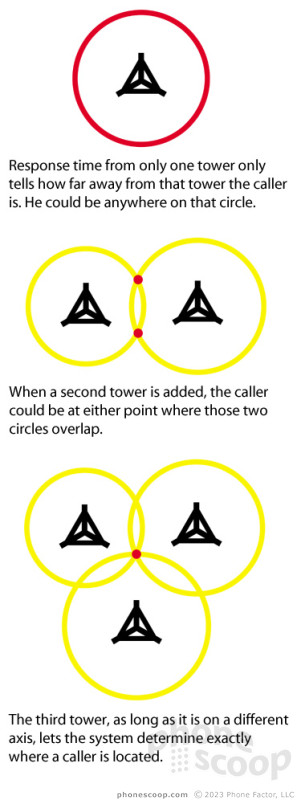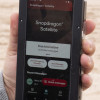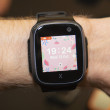State of Emergency
Aug 3, 2005, 7:00 PM by Eric Lin
A comprehensive look at the E-911 issue and the technology behind it. A complete survey of the initiative's history and current status.
The Plan(s)
Introduction
In 1996, back when cell phones were still a luxury item, a very forward thinking Federal Communications Commission (FCC) declared a set of requirements and deadlines for locating emergency calls originating from mobile phones. Known as enhanced 911, or e911, the requirements gave carriers 5 years to implement technologies that would accurately locate callers in distress. Nine years later, with the FCC's final deadline five months away, only about half of wireless callers can be accurately located.
Original Plan
The FCC devised a three-part plan for carriers to implement.
The first part was so simple and obvious, it was never talked about much. Carriers were given a year to forward all 911 calls made from cell phones to a local Public Service Answering Point (PSAP), the emergency call centers that cover the country. Like landline services, carriers had to forward emergency calls from any registered handset immediately, regardless of account status.
The second part, referred to as Phase I, required that carriers pass along the caller ID of the emergency caller to the PSAPs as well as the location of the network's tower relaying the call. Relaying this location was intended to assure that the emergency call was passed on to the appropriate PSAP, not necessarily to aid in finding the caller. This was supposed to be ready at the end of 1997, a year and a half from the start date at the latest.
Phase II required carriers to implement systems that allowed them to locate a caller with 125 meter accuracy 67% of the time, and to pass that location on to the appropriate PSAP if that answering point is capable of receiving the location information. Because Phase II would require new technology, carriers were given 5 years, until 2001, to test and build out the new network.
Best Laid Plans
It all seemed so simple, but nothing is ever as simple as it looks. Implementing the first phase - forwarding 911 calls - went relatively smoothly. Except that initially phone manufacturers thought it would be cool to include a separate 911 button on their handsets, which caused numerous unintentional calls overtaxing the 911 call centers.
The real problems began as carriers tried to implement Phase I. The carriers were off to a slow start, and due to bickering and technical glitches, the FCC extended the deadline for Phase I an extra six months, to mid 1998. Most carriers (with the notable exception of VoiceStream, now T-Mobile) were able to meet this new deadline with ease, but it didn't matter much. Most PSAPs weren't ready for Phase I.
Many answering points had equipment that would only let them receive a 7-digit caller ID, because when choosing equipment, the assumption was made that all calls would come from local wireline phones. PSAPs needed to upgrade their caller ID system to accept 10 digits, as well as upgrade their systems to receive Phase I location data (tower location).
Because of the expense of the upgrade, many PSAPs chose to wait until carriers started implementing Phase II, since it used a different location protocol that still was being finalized by equipment manufacturers and carriers.
Even today, only about 75% of PSAPs are Phase I compliant.
A New Plan
In 1999, the FCC revised the plan again. They were only 2 years away from the final Phase II deadline, but there were new details to work out. The FCC had based their original Phase II requirements on carriers using network-based technologies to locate handsets. However extensive testing from carriers led to two conclusions, each of which required new rules and deadlines.
First some network based solutions weren't good enough to meet the FCC's requirements. Cingular and AT&T had tested, and even installed a few solutions which failed to meet the FCC's guidelines. Still, the FCC revised their requirements to 100 meter accuracy 67% of the time and 300 meters 95% of the time.
Other carriers, CDMA carriers for the most part, decided on phone-based assisted GPS (aGPS). Assisted GPS uses the phone network to both speed up acquisition of GPS satellite signals as well as pinpoint location when satellite signals are weak (inside buildings, for example). It is typically much more accurate than network based technologies, however subscribers have to upgrade to a new phone in order to use it.
Since it would take carriers time to get new aGPS phones into subscribers' hands, the FCC eased the deadline on carriers that chose phone-based e911 solutions, but tightened the accuracy requirements. The FCC upped the accuracy ante to 50 meters 67% of the time and 150 meters 95%. The FCC gave the carriers until October 2002 to shift all the models they were carrying to aGPS capable handsets, and until the end of 2004 to make all reasonable efforts to achieve 100% penetration of aGPS phones. This deadline was later extended another year, to December 31, 2005 and reduced to 95% penetration.
Regardless of technology, carriers are required to have their networks ready for Phase II by October 2001. By that date, they had to be prepared to respond to PSAP requests. By the new rules, when a PSAP informs carriers it is Phase II compliant, phone based carriers have 6 months to provide that answering point with an interface to their location system. Network based carriers have 6 month to provide an interface and location coverage for 50% of users in the area and 18 months to provide full location coverage.
Current Status
Network Based
In 2001, it became clear that no one was going to meet the FCC's Phase II deadline for network-based location. Carriers applied for, and many were granted, waivers or extensions. These carriers were still looking for a solution that could meet the FCC's 100 meter requirement. Cingular and AT&T Wireless thought they had found a compliant technology (EOTD), and had begun installing it, only to find out it wasn't going to work. Cingular and AT&T were both fined for not meeting the FCC deadline with their equipment.
Finally, in 2002, carriers tested a network location solution that met the FCC's guidelines and began ordering equipment. Cingular, T-Mobile and some regional carriers built location networks based on U-TDOA technology. Carriers began installing this technology, and have nearly caught up to completing this installation in areas with Phase II ready PSAPs. The carriers will always lag slightly behind behind the number of Phase II compliant PSAPs because they are given 6 months to respond to a PSAP.
Many rural carriers which chose a network-based location scheme have recently been granted waivers by the FCC, allowing them to transmit only Phase I tower location data to emergency centers. These carriers typically install their cell towers in a line along major highways, making network based location impossible.
U-TDOA and other network based location technologies rely on triangulation to determine a handset's location. The handset is pinged by 3-4 towers and the time it takes for the phone to respond to each ping determines the phone's distance from each tower, and thus its location. In order to determine the phone's location, it needs to be between at least 3 towers on at least 2 axes. With towers along only 1 axis, such as a highway, networks could only determine the latitude but not longitude (or vice versa).
(See the illustration below for a visual explanation of triangulation.)

Phone Based
In 2002 Sprint was able to announce that their network was e911 ready. However Sprint, like most of CDMA carriers had chosen a phone-based location technology. Sprint's network readiness merely indicated they could send location information to PSAPs that were Phase II compatible.
In 2000, the FCC gave carriers until 2002 to ensure that all new digital handsets sold are Phase II compatible, and extended the deadline for total penetration to 2005. Since 2003, all digital CDMA phones sold by major national and regional carriers, as well as iDen handsets, have aGPS built in for location. However a number of people have older handsets without any location technology. Some people simply haven't felt the need to upgrade their handset yet, while others - especially those in rural areas - have chosen not to upgrade as they prefer the option to use analog services in places where digital signals are weak.
With the deadline for subscriber penetration quickly approaching, the CTIA, on behalf of the carriers, has petitioned the FCC to waive the 95% requirement. Carriers have yet to include data on current penetration of Phase II compatible handsets in their reports to the FCC, but all mention they have no means of forcing subscribers to upgrade. Recently Nextel revealed that in a best case scenario, 70% of their subscribers will have aGPS handsets by the deadline. Sprint will come close to, if not actually achieve the 95% guideline. Verizon believes they could achieve 90% penetration among subscribers.
The FCC has not yet made a decision on this waiver. Should they decide not to waive it, some carriers will have to scramble with special offers and possibly with network improvements in order to convince a large number of subscribers to upgrade in a short period of time. Or it's possible the FCC could simply extend the 95% penetration deadline again.
Poor PSAPs
Despite all the FCC's efforts to get carriers ready to transmit location data to PSAPs, it has no authority to get the PSAPs ready to receive this data. Emergency call centers fall under local or state jurisdiction. Despite efforts from the FCC and cooperation from carriers, PSAPs are at the mercy of local governments that fund them.
To do their part, the carriers have cooperated with local governments by adding e911 tariffs on cell phone bills for years now. That money, which was supposed to be earmarked for PSAP upgrades, has been diverted by many states to cover other emergency costs. New York state has been noted as the worst offender, diverting e911 funds for everything from new police vehicles to winter boots. Last year the Federal government began created a committee to oversee e911 call center upgrades and offer $250 million per year grants to states that did not divert e911 funds to other projects.
As of the latest report, just over 40% of all PSAPs have been upgraded to Phase II compatibility. The outlook is slightly less bleak when broken down by population. According to this month's (July 2005) reports from the National Emergency Number Association (NENA), the organization that manages PSAP readiness, 57.5% of the US population has some coverage by a Phase II-ready call center.
This 57.5% is a best case scenario. It cannot account for callers on carriers that have not yet begun transmitting location data to those call centers, nor can it factor in the number of callers with or without aGPS phones. Still it shows some indication that many states are spending their resources to benefit the most residents, upgrading PSAPs in more populous areas first.
While that formula holds true on a local basis, it breaks down on a state wide basis. Only 4 of the 10 most populous states - California, Florida, Illinois and Texas - cover more than half of residents with Phase II compliant PSAPs. Ohio, the worst prepared of the top 10, covers less than 2% of its population.
What Can You Do?
There are horror stories that circulate about emergency callers whose phones are not e911 ready or who call into centers that are not yet ready. If you are on CDMA network, you would be wise to be sure that your handset has aGPS. if you bought your phone new from a major carrier in the past two years, it should have GPS built in. If your phone is older or you're unsure, phones typically display a crosshair icon in the status bar to indicate it has working GPS. If you have a new phone and have chosen to turn location services off, you will not see a crosshair icon, however if you dial 911 location services will automatically be activated. It should be noted that if you are on a GSM network, all phones work with network based location; you do not need a special handset.
Having a location-ready handset or network doesn't just benefit you in emergency situations. It also gives you access to location based services (LBS). Nextel currently leads the way with these, providing all sorts of of benefits from local recommendations to turn by turn driving directions and in enterprise situations, fleet/staff tracking. Sprint is now launching location based services as well. Although AT&T was one of the first carriers to offer LBS in the form their friend finder and a few other applications, no GSM carrier is currently offering any such services in the US.
While every quarter, each carrier must file a list of the PSAPs it has connected to, it would be impossible to check on the status of every PSAP you might call in to. There is no simple way to find this data. However it's easy to check the general readiness of your state. NENA maintains current statistics of the percentage of counties in each state with Phase II readiness as well as percentage of state population covered by Phase II ready call centers.
If your state's call centers cover less than 25% of the population (some states still cover no one), it wouldn't hurt to call your state representative (this is not an issue for your congressman or senator) and let them know you're concerned about the sad state of emergency readiness there. With all the focus on homeland security in the past few years, they might be receptive to your concerns. Typically the more people who call, the more legislators are willing to pay attention, so tell your friends too. You could even send something to your local paper or tv station tipping them off to this situation.
Unfortunately about all you can do is make some noise. Your carriers and the Federal government have done just about everything they can. The PSAPs need money from local governments to complete their upgrades. You need to let your local government know that this is a worthwhile way to spend their money, especially since most have money that was supposed to be earmarked specifically for this purpose.
Comments
CRAPOLA!!!
Slomin Shield and i haven't heard of a government imposed free security system law...SCREW THE FCC AND ALL IT'S CRAP IT WON"T EVEN LEAVE STERN ALONE!!!!!
by the way i am suprised that the maker of this site wasted his time on this crap...but oh well.
But, just for the sake of arguing the FCC's case...
The whole reason for E-911 is that with regular 911, the operator knows where y...
(continues)
carriers network rolls back phase II to phase I
this was a known issue and told to the local authoritities ahead of time. The fact is that this can happen with any carrier and not to assume that phase to is current on any particular day.
check your local situation
The state's emergency management does not coordinate 911 in Colorado or really have anything to do with the emergency centers receiving the calls. They are all locally controlled and coordinated.
The funds collected via the tarrif does go to the PSAP but can be used for a variety of operational costs including upgrades but not exclusively for upgrades. Many PSAP also use general funds for their upgrades.
THERE IS NO PSAP DEADLINE FOR UPGRADES.
You should check with your state PUC to determine the current statut of your PSAP (in colorado their are over 40 PSAPs). A list ...
(continues)
Question About A-GPS with Verizon
Hey Rich Question
Interesting piece
All the phone reviews and releases and conferences are great but some days (especially when we're in a sales slump and the carriers are jerking us around like now) I just don't care about Samsung's latest gadget. This piece was really intresting as I had no idea it was such a complex (nor depressing, nor frustrating... 😡 😕 )situation. Knowing alot more now, I am going to look into where compliance is at near me. Since I'm the cell guru in my social circle, if compliance isn't up to snuff I think I might send out a mass email to my address book to talk to their state reps.
But...yeah...Bravo.


 iPhone 14 Plus Offers a Big Screen For Less
iPhone 14 Plus Offers a Big Screen For Less
 Qualcomm Taps Iridium for Satellite Connectivity
Qualcomm Taps Iridium for Satellite Connectivity
 Apple Watch Goes Ultra
Apple Watch Goes Ultra
 Bullitt Announces First Phones with Satellite Messaging
Bullitt Announces First Phones with Satellite Messaging

